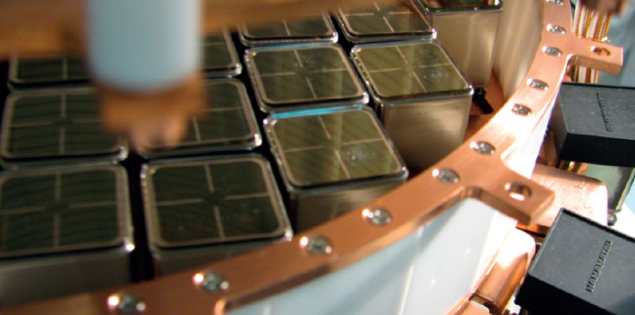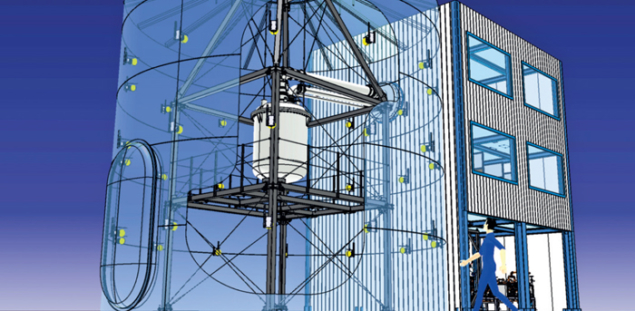The XENON collaboration’s search for dark matter.

Numerous astronomical observations indicate that about one quarter of the energy content of the universe is made up of a mysterious substance known as dark matter. The Planck collaboration recently measured this to the precise percentage of 26.8%, which is slightly greater than the previous value from nine years of observations by the Wilkinson Microwave Anisotropy Probe (WMAP). Dark matter, which is five times more abundant than baryonic matter, provides compelling evidence for new physics and could be made of a new particle not present in the Standard Model. Theories beyond the Standard Model, such as supersymmetric models or theories with extra dimensions, suggest promising candidates and naturally predict so-called weakly interacting massive particles (WIMPs), which are stable or have lifetimes longer than the age of the universe.
There are several complementary strategies to detect dark matter. The ATLAS and CMS experiments at the LHC search for such particles produced in proton–proton collisions. Indirect searches, for example by the AMS-02 or IceCube detectors, aim at detecting the products of dark-matter annihilation in cosmic rays.
Because dark-matter particles are expected to be abundant in the Galaxy, with an energy density of about 0.3 GeV/c2/cm3 at the location of the Sun, the most direct strategy is to look for their interactions in laboratory-based detectors. In general, it is possible to study spin-independent WIMP–nucleon interactions – which scale with the square of the target’s mass number, A – or spin-dependent couplings to unpaired nucleons in the target nucleus. Because of their nonrelativistic Maxwellian velocity distribution with a typical speed of around 220 km/s and because the WIMPs interact significantly only with nuclei (and not with the electrons), the expected signal is a featureless exponential nuclear-recoil spectrum. The recoil energies depend on the mass of the WIMP and on the target material and are typically of the order of a few tens of kilo-electron-volts.
Because the expected interaction rates are small, a sensitive WIMP detector needs to feature a large target mass, an ultralow background and a low energy threshold. In addition, it should allow the distinction of the nuclear-recoil signal (from WIMPs and also from background neutrons) from the overabundant electronic-recoil background from γ and β radiation.

Image credit: XENON collaboration.
The most sensitive dark-matter detector to date is XENON100, which is operated by the XENON collaboration and situated at the Italian Laboratori Nazionali del Gran Sasso (LNGS), under about 1.3 km of rock that provides a natural shield from cosmic rays. The experiment searches for WIMP interactions in a target of 62 kg of liquid xenon. The noble gas xenon is cooled to around –90°C to bring it to the liquid state with a density of around 3 g/cm3. Its high mass number, A, of around 130 makes it one of the heaviest of all target materials for dark-matter detection.
The detector was built from materials selected for their low intrinsic radioactivity
XENON100 is operated as a dual-phase time-projection chamber (TPC), as figure 1 illustrates. Particle interactions excite the liquid xenon, leading to prompt scintillation light, and also ionize the target atoms. A uniform electric field causes the ionization electrons to drift away from the interaction site to the top of the TPC. Here a strong electric field extracts them into the xenon-gas phase above the liquid. Subsequent scattering on the gas atoms leads to signal amplification and a secondary scintillation signal, which is directly proportional to the ionization extracted. Both the prompt and secondary scintillation light are detected by two arrays of low-radioactivity photomultipliers (PMTs), which are installed above and below the cylindrical target of around 30 cm height and 30 cm diameter (figure 2). The PMTs are immersed in the liquid and gaseous xenon to achieve the highest-possible light-detection efficiency and therefore the lowest threshold. The 3D position of the interaction vertex is obtained by combining the time difference between the prompt and the secondary scintillation signal with the hit pattern of the localized secondary signal on the array of 98 PMTs above the target. The number of secondary signals defines the event multiplicity.
The detector was built from materials selected for their low intrinsic radioactivity. Thanks to its novel detector design – placing most radioactive components outside of a massive passive shield – and the self-shielding provided by the liquid xenon, XENON100 features the lowest published background of all dark-matter experiments. The self-shielding is exploited by selecting only events that interact with the inner part of the detector (“fiducialization”) and by rejecting all events that exhibit a coincident signal in the active veto, which is made of 99 kg of liquid xenon that surrounds the target. Because of their small cross-section, WIMPs will interact only once in the detector, so background can be reduced further by selecting single-scatter interactions with a charge-to-light ratio typical for the expected nuclear-recoil events.

In the summer of 2012, the XENON collaboration published results from a search for spin-independent WIMP–nucleon interactions based on 225 live days of data (XENON collaboration 2012). No indication for dark matter was found but the derived upper limits are the most stringent to date for WIMP masses above 7 GeV/c2. The same data have now been interpreted in terms of spin-dependent interactions and the results published recently (XENON collaboration 2013). This latest analysis requires knowledge of the axial-vector coupling and the nuclear structure of the two xenon isotopes with unpaired nucleons, 129Xe and 131Xe. Improved calculations were employed here, which are based on chiral-effective field-theory currents. Compared with older calculations, these yield superior agreement between calculated and predicted nuclear energy-spectra (Menendez et al. 2012).
The specific nuclear structure of the relevant xenon isotopes leads to different sensitivities for the two extreme cases that are usually considered. For the case where WIMPs are assumed to couple to protons only, the new XENON100 limit is competitive with other results (figure 3). Indirect dark-matter searches looking for signals from the annihilation of WIMPs trapped in the Sun (which mainly consists of protons) are particularly sensitive to this channel. For the neutron-only coupling, XENON100 sets a new best limit for most masses, improving the previous constraints by more than an order of magnitude (figure 3).
The aim is to reach a dark-matter sensitivity two orders of magnitude better than the current best value
While XENON100 continues to take science data at LNGS, the development of a larger liquid-xenon detector is well under way. XENON1T will be about 35 times larger than XENON100, with a TPC of around 100 cm in height and diameter. The aim is to reach a dark-matter sensitivity two orders of magnitude better than the current best value. This will probe a significant part of the theoretically favoured WIMP parameter space but will require the radioactive background of the new instrument to be 100 times lower than that of XENON100. The greatly increased liquid xenon target mass of more than two tonnes helps to achieve this goal.

Image credit: The XENON collaboration.
The largest background challenge comes from uniformly distributed traces of radioactive radon (mainly 222Rn) and krypton (85Kr, present in natural krypton at a fraction of about 10–11) dissolved in the xenon, because the background from these isotopes cannot be reduced by target fiducialization. To achieve the background goals for XENON1T, the contamination of radon and krypton in the xenon filling will be reduced to below a level of parts per 1012 by careful material selection and surface treatment and by cryogenic distillation, respectively. Additionally, all of the construction materials for the detector are being carefully selected based on their intrinsic radioactivity using ultrasensitive germanium detectors. A few of the world’s most sensitive detectors are owned and operated by institutions in the XENON collaboration.
The XENON1T detector will be placed inside a large water shield to protect it from environmental radioactivity (figure 4). The water will be equipped with PMTs to tag muons via emission of Cherenkov light, because muon-induced neutrons could mimic WIMP signals. The construction of the water tank is underway in Hall B of LNGS and will be finished by the end of 2013. Together with the XENON1T service building, it will be the first visible landmark of the experiment underground. The other XENON1T systems – from detector and cryogenics to massive facilities for the storage and purification of xenon – are currently being designed, built, commissioned and tested at the various collaborating institutions. In particular, the challenges associated with building a TPC of 100 cm drift length, which will be the longest liquid xenon-based TPC ever, are being addressed with dedicated R&D set-ups.
Once the main underground facilities are erected, the XENON1T low-background cryostat – to contain the TPC and more than three tonnes of xenon – will be installed inside the water shield. The infrastructure for the storage, purification and liquefaction have been designed to handle more than double the amount of xenon initially used in XENON1T. Their commissioning underground is expected to be completed by the summer of 2014. The timeline foresees commissioning of the full XENON1T experiment by the end of 2014 and the first data by early 2015. After two years of data-taking, XENON1T will reach a sensitivity of 2 × 10–47 cm2 for spin-independent WIMP-nucleon cross-sections at a WIMP mass of 100 GeV/c2. This is a factor 100 better than the current best WIMP result from XENON100.







